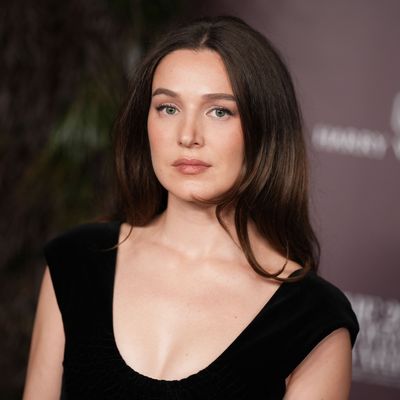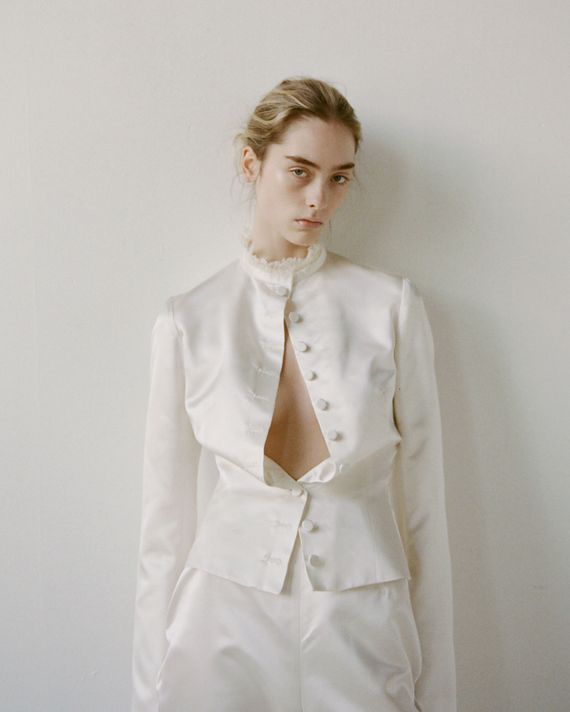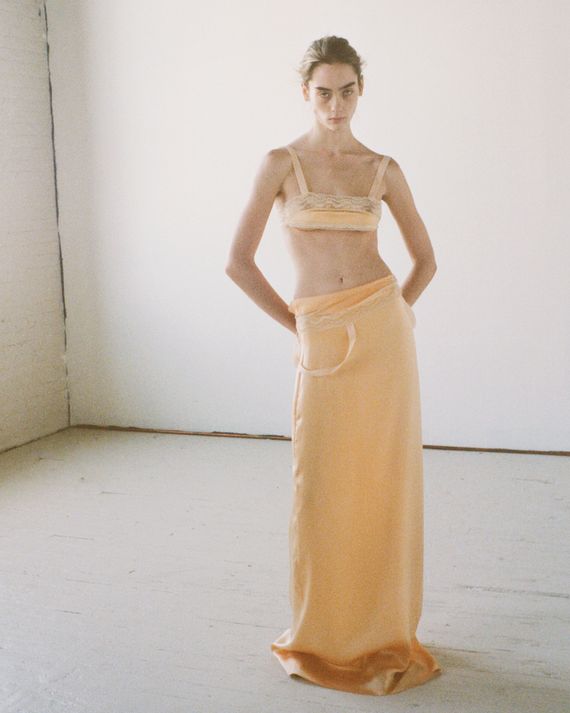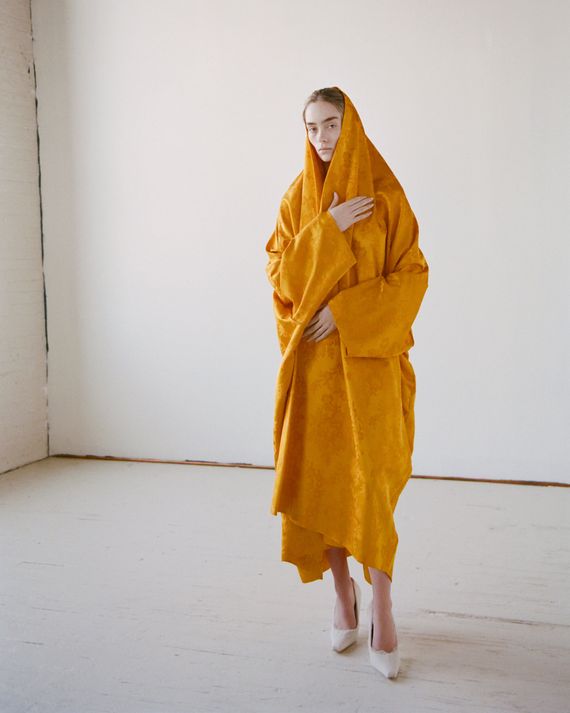
Colleen Allen, a Brooklyn-based designer, showed her first eponymous collection in February of 2024 — and mesmerized much of the New York fashion industry with her lacy separates and gowns saturated in rich reds, purples and oranges, tones that make you want to bite into a ripe piece of fruit and feel the earth under your feet.
The designer, whose background was originally in menswear, graduated from Central Saint Martins and then interned under Raf Simons at Calvin Klein. Afterward, she spent three years cutting her teeth at The Row before going out on her own. Allen’s silhouettes are often nipped and tailored, mildly witchy and evocative of silhouettes prominent in the Victorian era, but minus all the pinching and prodding we associate that time with. Looking at her clothing is like taking a spin in a time machine: dazzling and otherworldly. Ahead of the CFDAs, where Allen is nominated for Emerging Designer of the Year, the designer sat down with the Cut to talk about inspiration, her creative process, and how it never gets easier.
When you found out you were nominated for a CFDA, what went through your head?
There’s something really meaningful to me about being recognized, because I also have put in so many years to get to where I am now. I keep thinking about all the people that are going to be in that room, and it’s been reflective and cool. Peter Mueller is getting an honorary award and I used to intern at Calvin Klein and presented projects to him as a really young, very green intern. To be nominated in the same room as him receiving an award is quite surreal. The Row has some nominations too, and they were my first real design job.
Looking forward over the next few years of your career, or next decades, is there something that you feel like you have to accomplish in order to feel like you’ve reached the pinnacle?
There’s definitely fantasies of what I would love for my career to look like, at the center of that is being able to sustain and keep my own special world of this brand. I get to live in my special little universe — that’s the ultimate fantasy.
You got your first design job at The Row. When did you know it was time to go out on your own?
Leaving to do my own thing was about finding my own personal identity, and the only way I could do that was by building this creative work to figure it out. I wanted to understand who I was as a woman. Getting up and getting dressed in the morning, I just felt this sort of disembodiment that I couldn’t figure out. I just needed to do it for myself. Now it’s about personal exploration, figuring out who I am and how I exist and how that evolves as the world around me changes.
What is your creative process like? What’s going through your head as you begin designing a new collection or new
It’s very sensorial — the color and materiality are the mechanisms I use for this immersive, spiritual transformation.
I start in a very material way - there’s always one center point where then all these other colors come in as conversational: surrounding each other, contrasting each other, supporting each other. When I’m sourcing materials, it’s very much about touching everything.
In terms of shape and proportion, the research comes from historical references. Part of that comes from a menswear background, and having never done womenswear, I have this very fun naivete toward these women’s references. I feel like I’m learning a new language. What does it mean to be a woman? What is a woman’s wardrobe made of? When I’m going into these historical references, there are layers of getting dressed in a way that we don’t have in the contemporary wardrobe. And I’m not interested in going back to restricted, conservative dressing. It’s more so: what’s an underpinning? What’s a coat? What’s a bodice? What’s a dress? Those all come together to create one total proportion or look rather than the way that we think about clothes now.
Do you have a certain historical era that you find yourself referencing often?
I’m always going to have a sense of the Victorian era there. One of the reasons I’m so drawn to it is because the proportions of that time are so incredibly tailored, and for somebody from a tailoring background, the way that they cut things and made things is so far away from what menswear tailoring is. There’s just so much richness to the clothes of that time. And aesthetically, it really aligns with the undertones of witchiness I like. There’s a bit of darkness in the Victorian times. But last season, I went for a more 1930s/1940s lingerie vibe. I don’t want to limit myself to one world.
How did you go about developing that taste?
I’m always going to museums, watching films. I don’t think I was born with this certain sense of identity. It comes from this immersion in culture, and that’s genuinely what I love to do with my free time. Creating this brand was parsing out, what do I like? and what don’t I like? and having the space and the permission to do that by myself. When you work for other people, it’s about curating it for their world, which is incredible and a great skill to develop before you do your own thing.
The reason I didn’t do womenswear from the beginning was because I looked at the fashion industry, and I didn’t see anything that I identified with. Being able to create that space was definitely a reaction to being a woman in America and the tensions of that. It can come from anger and things I hate as much as things I love and am obsessed with.
Your work is so ranging, and you don’t want to limit yourself, but if you had to pinpoint one silhouette or color to describe “the Colleen Allen look,” what would it be?
At this point in time I’d describe my looks as high neck, a tailored waist in a strange color, and probably in velvet. And I love a hook and eye, giving that little point of light and reflection that grounds the color in that way. When I finish something, it has to have a sense of naturalness. I line the insides of many of the pieces in a wash muslin, which is very earthy to me. It takes these more precious materials, or strange colors, and grounds it.
When you’re creating a new line, where are you drawing inspiration from?
Last season, I was collecting all this antique 1930s and 1940s lingerie, because they were just really special, precious objects. I was really reacting to the physical nature of them, finding these pieces that you just really can’t find — contemporary objects of clothing with that level of intimacy and care. I wasn’t entirely sure what to think about them, aside from them being beautiful objects. But as I was building boards, and while I was doing that, I was listening to this audiobook biography of Sylvia Plath. It was so incredible. The beauty and tragedy of her life was about the struggles and the expectations of women at that time, and it’s a weird reflection of what’s going on in America now with this sort of nostalgia for that period of time that— of women in the home. But there was so much darkness and so much struggle around that dynamic. That is something that I was so obsessed with in contemporary culture and reading that book, you see history repeating itself
So those objects are exactly the struggles women in America are dealing with right now. Even though they’re little, beautiful bras and underwear, they’re a symbol of how women were supposed to be in this domestic space in the home; these things are not ever to be seen in the outside world by anybody but one your husband. And I think that Sylvia was this creative, prolific genius, and she was really bogged down by the expectations and the responsibilities of having kids and the expectation of being a wife. Her real passion was her work.
When everything feels so incredibly online and the creative world can feel so homogenous sometimes, how do you keep your own vision clear?
You just can’t get from the internet. I don’t put up any active defenses. I’m not afraid of interfacing with what’s going on on the internet, because I do think that the physical processing of that information into the clothes always transforms them. But I don’t usually reference anything contemporary. That’s very important to me.
Is there anything or anyone contemporary you reference at all?
I’m always listening to Ethel Cane in the studio right now. I’m obsessed. I went to her concert at Radio City. She builds a very narrative world. There is this sort of fantasy and a character, and it touches every single element of the work.





